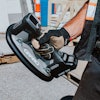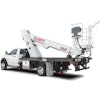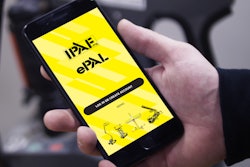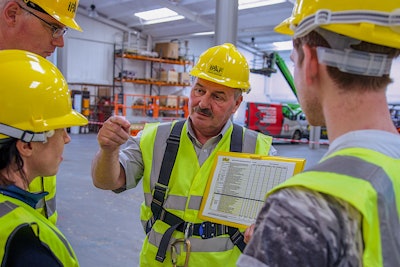
A well-accepted practice in major industries refers to the importance of training workers on how to do an activity in the safest possible way, as this will reduce their chances of being part of an incident with consequences such as injury, death, property damage, and loss of productivity.
Providing MEWP operator training is not a new requirement and aims for the same benefits of reducing the possibility of a workplace incident. Users/employers of MEWP operators have long been required, either by country regulations or published standards, to ensure their personnel received MEWP operator training, MEWP model-specific familiarization, and are qualified for the task prior to authorization to operate a MEWP. However, a misconception that is implemented to a lesser degree today, sees some employers accepting the model-specific familiarization provided by rental companies at the time of delivery as satisfactory “operator training.”
Proper MEWP operator training includes instruction that enables the trainee to become a qualified person to conduct the task to be performed, including knowledge regarding potential hazards. It specifies requirements for application, inspection, training, maintenance, repair, and safe operation of MEWPs. Familiarization is the necessary information regarding the features, functions, devices, limitations, and operating characteristics as defined by the manufacturer in the operator's manual, including the verification that the manufacturer’s operation manual is stored on the MEWP for ongoing reference.
As is often the case, if a MEWP user does not understand the difference between, and the need for, MEWP operator training and familiarization, it is likely they are not choosing the right training. That can lead to workplace incidents, as the operator won’t know all available information on how to safely operate the MEWP and proactively respond to environmental conditions.
In June 2020, new industry standards went into effect for the design, safe use, and training regarding MEWPs. The safe-use standard defined the responsibilities regarding the requirements for safe MEWP operations and training of personnel. The training standard defines what needs to be included in training, and how it is to be delivered. While much of what was added in both the safe-use and training standards should have already been in place, the standards added details to better ensure complete, consistent, and compliant training is provided to MEWP operators.
A group of industry training experts, made up of Jake Kidd, Sunstate Equipment; Bart Krzysztofek, Skyjack; Scott Owyen, Genie; Bal Guerrero, United Rentals; and myself, have shared responses to questions that will assist MEWP users/employers selecting standardized and effective training for their workers prior to authorization of MEWP operation. Their answers are summarized below.
Q: How can a user select appropriate, standardized, and effective MEWP operator training for their personnel?
It is extremely helpful if the user is familiar with the training requirements outlined in the ANSI A92.24 and CSA B354.8 standards (for the U.S. and Canada, respectively). The training standards provide methods and guidelines to prepare MEWP training materials, define administrative criteria, and deliver elements required for proper training and familiarization. Both standards incorporate provisions from the respective countries’ safe-use standards to address requirements for application, inspection, training, maintenance, repair, and safe operation of MEWPs.
 IPAF
IPAF
Published in 2010, another excellent resource that is available for free is the Statement of Best Practices of General Training and Familiarization for Aerial Work Platform Equipment. Created by industry associations involved with MEWP safe-use, the document clarifies what is required for general training and model-specific familiarization of aerial work platform (AWP) equipment, now known as MEWPs. While it references prior industry standards in effect at the time, the guidance still applies today as a tool to understand MEWP operator training and familiarization requirements and safe practices.
If you are looking to outsource your training needs, start with your MEWP manufacturer, which has the responsibility to develop and offer training materials that will aid dealers, owners, users, supervisors, operators, and occupants to comply with their responsibilities for training and familiarization. Further, consider training provided by a leading and well-recognized training provider (such as IPAF-approved training centers); this will also ensure that the training will be appropriate, effective, and compliant with the most up-to-date industry requirements. Like any other purchase you make, you should ask questions of the training provider to verify that the training will be of sufficient length and substance prior to scheduling the course.
Q: What are some of the administrative criteria required for effective training?
Training administration must ensure the training provided is thorough and consistently delivered regardless of by whom, where, and when it is delivered. While training content is important, it is only one part of the learning equation. Effective training occurs when complete and thorough content is provided through effective delivery methods, facilitating the training to be understood, retained, and implemented by trainees.
Training administration has several tasks to manage:
- Qualified instructors: The training should only be delivered by a qualified person, who is trained and experienced in the safe operation of various types of MEWPs; understands and can explain the rules, regulations, and standards that apply to MEWPs; understands manufacturer’s requirements; and is familiar with how to recognize and avoid hazards associated with their operation.
- Complete and thorough curriculum: The curriculum for operator training shall incorporate the topics and subjects listed in the industry standard for both MEWP theory and practical training. The curriculum must clearly identify that training covers only the classification for the MEWP(s) included in the training.
- Appropriate training environment: The environment where training occurs must be free from hazards and supportive to learning (eliminate distractions). The theory training environment should incorporate proper lighting and acoustics, room size, and capacity to accommodate the number of trainees, provide adequate heating and air conditioning, provide appropriate presentation equipment, ensure visibility for all trainees of the presentation, and access to restroom facilities. Students should also be given breaks from the training on an hourly or so basis. Note that the same considerations should apply when using online eLearning courses.
The practical (hands-on) training environment should be a dedicated area set aside for training that is free from other moving equipment and personnel traffic. Warnings such as flags, roped off areas, barricades, or flashing lights shall be used when appropriate. The location must include a firm, level ground capable of supporting the weight of the MEWP and occupants in the platform. Coning the area off to alert personnel that training is taking place is always a good idea. Other considerations may include methods to test oscillating axles, tilt sensors, pothole guards, etc. A risk assessment is required for each location where a practical test is to be given to identify, eliminate, or mitigate all hazards and risks associated with safe use of the MEWP during training.
- Written testing for theory and practical training: To demonstrate competency, each trainee must prove their proficiency in both theory (classroom/online) and practical (hands‐on). The measure of proficiency is documented though the testing results and practical evaluations. Industry standards offer examples of the testing to consider with your training.
Note: Prior standards simply stated that, “Each trainee, under the supervision of a qualified person, shall operate a MEWP for a sufficient period of time to demonstrate proficiency in the actual operation of the MEWP.” Training administration must define, “How long is a sufficient period of time?” and “how do we measure proficiency?” - Personal documentation: Upon successful completion of the training program, the MEWP user shall be furnished with proof of training by the training entity referencing compliance with the specific training standard, including the name of training company and trainer, MEWP classification in the training class, date of training, name of successful trainee, and expiration date of training validity.
- Record retention: Training records shall be dated and retained by the user for at least the period of time the training is valid, and the familiarization records will be retained for at least four years (U.S.).
Q: What is the required content for MEWP operator theory training and practical (hands-on) training?
The standards clearly outline the requirements for content in both theory and practical hands-on training. The theory training needs to address more than the basics of how to make the machine move and must include, but is not limited to, the proper selection of the correct MEWP for the work to be performed; the rules, regulations, and standards that apply to MEWPs; the purpose and use of operator’s manuals, placards, and decals, and the requirement that the manuals must remain on the machine at all times; how to perform a pre-operation inspection on the machine prior to use; responsibilities associated with problems or malfunctions that affect safe operation; factors that affect the stability of the machine; hazard recognition and avoidance; how to perform a workplace risk assessment including rescue planning; the proper use of personal protective equipment; securing the MEWP from unauthorized use, and occupant instruction.
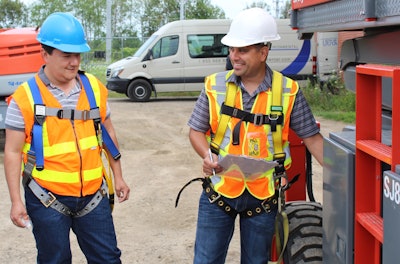 IPAF
IPAF
Designing and delivery of appropriate practical testing is part of the administration of training that ensures the operator is required to operate and function all controls in the completion of the practical course task/test. As jobsites, MEWP equipment, and tasks vary, MEWP operator training alone does not make an operator qualified for every task but provides the foundation to enable each successful trainee to become qualified. The user is responsible for assessing if personnel are qualified to perform the task.
Q: What are some of the attributes one needs to be a qualified MEWP instructor?
In addition to being properly trained on the delivery of the MEWP operator training theory and the practical course to be delivered, an instructor must be experienced in the safe operation of the various MEWPs categories and accessories; possess an understanding of, and be able to clearly explain, the rules, regulations, and standards that apply to MEWPs; have an understanding of MEWP manufacturer’s requirements; and be familiar with how to recognize and avoid hazards associated with their operation and complete a site risk assessment for all areas where training will be delivered.
MEWP training instructors should have excellent communication and presentation skills, and understand the teaching methods and learning styles of adult learners. The instructors must demonstrate integrity, confidence, and create a safe, open, honest learning environment where trainees are comfortable asking questions and sharing experiences. They must have great organizational skills and be effective time managers to ensure all training is delivered within the set times of the training day communicated to the trainees. Being passionate about safety helps position the trainer as a trusted confidant and advisor in the eyes of students, with the ability to convey the “why” safety is important – no shortcuts. When presented correctly, the class itself should be the beginning of a lasting relationship between instructor and students.
Q: What testing is required to measure proficiency of MEWP operator theory and practical training?
Each student must show proficiency in both theory and practical hands‐on training. The theory training typically involves a written test to confirm the level of comprehension of the covered material. The practical hands-on training involves the student demonstrating proficiency in the application of theory knowledge and actual operation of a MEWP in front of a qualified trainer that requires the operation and function of all controls. A Q&A with candidates, following instructor directions and visual evaluations, is also included in practical testing.
The industry standard offers a non-mandatory annex with examples of both theory and practical testing of MEWP operator knowledge and operational proficiency observations for the instructor to include in the evaluations. The examples identify and provide a thorough list of topics and observations that should be considered in testing used in training.
"As jobsites, MEWP equipment, and tasks vary, MEWP operator training alone does not make an operator qualified for every task but provides the foundation to enable each successful trainee to become qualified" - Bal Guerrero, United Rentals
Specific to the practical training, it’s good to have planned tasks for the operator to complete and use a document to record operational faults with a demerit point system to verify and document the operator’s proficiency.
Testing must be documented for both theory and practical training, and given the examples provided in industry standards, required testing IS well-documented and should be used.
Q: What personal documentation is required for the training?
The standards provide a simple list required upon successful completion of the training. The trainer must provide the trainee/user proof of training that references compliance with the standards. The proof of training must include:
- The name of the entity providing training.
- The name of the trainer.
- Identification of the classification(s) of MEWP covered in training.
- The date of training completion.
- The name of trainee.
- The period of time training is valid (if applicable).
The training records must be kept by the user for at least the period of time that the training is valid.
Q: How long should one expect MEWP operator training to take? Are there variables to consider?
Industry standards define required performance and not a required amount of time to accomplish the task. As such, the amount of time to complete MEWP operator training has varied significantly in the market. The introduction of a MEWP training standard will hopefully narrow this variance and better ensure that complete, consistent, and compliant training is delivered. It’s important to give the trainees a quality training experience and allow them to gather as much knowledge as possible— and that does take a certain amount of time.
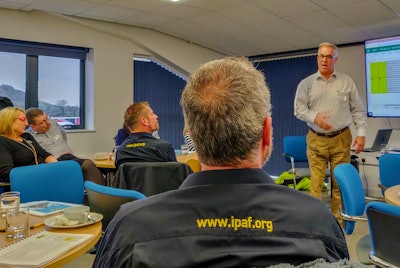 IPAF
IPAF
The Statement of Best Practices of General Training and Familiarization for Aerial Work Platform Equipment from 2010 states that general training (classroom/online plus the practical hands-on training should take three to six hours or more, depending upon the class size and number of MEWP classifications to be covered. There are variables to consider such as how many people will be in the class, how many MEWP classifications will be covered in the class, and which models will be used (for example, a small electric boom will take much less time than a large rough terrain boom, even though they are the same classification). It is widely accepted that a full eight-hour day is the time that should be allocated to a MEWP training class with four to six trainees on two categories.
At Genie and Skyjack, both very proficient in the delivery of training, it is reported that MEWP training courses, including both instructor-led theory and hands-on practical, typically last six to eight hours or longer if they are covering more than one classification. IPAF training does not allow the training of more than six trainees on two categories of MEWP when theory and practical are being delivered in a single day.
If you consider that theory training eLearning courses take on average between two-and-a-half and three hours to complete start to finish without breaks, the same course material is used for instructor-led training, so three to four hours is a reasonable time for theory training. Add a lunch break, and you can begin your practical testing and evaluations to this time.
Practical testing requires the group to review site risk assessment and workplace inspections – verifying each trainee can complete one (20 minutes minimum), a MEWP model familiarization on each MEWP being used in the training (15 minutes each x two categories = 30 minutes), a group prestart inspection that requires involvement of each trainee to ensure their proficiency in the visual inspection and function test of every control at both ground control and work platform control (20 minutes each x two = 40 minutes), followed by instructions of the practical test route and operational task (5 minutes x two = 10 minutes), followed by the operation on each MEWP category by each trainee (15 minutes scissor x six trainees = 90 minutes + 20 minutes boom x six trainees = 120 minutes). That makes a TOTAL of 310 minutes/60 = 5.2 hours.
Combined with the four-hour theory training including lunch and breaks, you have a 9+ hour day. It may be possible to complete this inside eight hours – but four hours? The number of trainees and categories of MEWP in the training are the main variable for total time for the training.
The panel of experienced trainers add that in their experience, other real-world factors include the number of extra breaks the students take, how long they take to return from lunch, the number of questions that are asked, weather conditions, complexity of equipment or task, and the length of the discussions that arise. Questions and discussions should be encouraged and not rushed. All of these issues must also be managed to ensure all required training is delivered within the scheduled time.
"The group’s agreed opinion is that if a training organization claims that they can teach a MEWP class in less than three or four hours, they are not covering the required information properly, which can give the students a false sense of security and lead to extremely dangerous situations" - Scott Owyen, Genie
The group’s agreed opinion is that if a training organization claims that they can teach a MEWP class in less than three or four hours, they are not covering the required information properly, which can give the students a false sense of security and lead to extremely dangerous situations. All have had a shockingly large number of students that have shown an operator training card that they received from a previous training entity that states that they are a qualified operator, and they stated that it only took 30 minutes or less to get the card.
Clearly, we as an industry must put a stop to that incredibly dangerous behavior. Articles like this one can go a long way in educating employers and safety personnel on what constitutes appropriate and effective training.
![Tony Groat Edited 5b57430ec070e[1] Headshot](https://img.forconstructionpros.com/files/base/acbm/fcp/image/2024/06/Tony_Groat_edited.5b57430ec070e_1_.667c30792412c.png?auto=format%2Ccompress&crop=faces&fit=crop&h=48&q=70&w=48)
